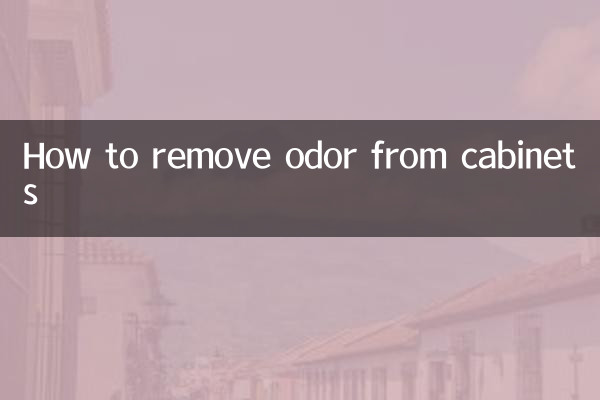How to remove odor from cabinets: a collection of popular methods on the Internet
Cabinet odor is a common problem that plagues many families, especially new cabinets or cabinets that have been sealed for a long time are more likely to produce odor. This article will combine the hot topics and hot content on the Internet in the past 10 days to sort out a set of scientific and effective methods for removing cabinet odors, and present them in structured data to facilitate you to quickly find a solution that suits you.
1. The main source of cabinet odor

| Source of odor | Proportion | Common symptoms |
|---|---|---|
| Formaldehyde release from new cabinets | 45% | Pungent chemical smell |
| Moisture and mildew | 30% | musty smell |
| Long-term airtight without ventilation | 15% | Dull smell |
| pest contamination | 10% | Special fishy smell |
2. Effective methods to remove cabinet odors
Based on the most popular deodorization methods and expert advice on the Internet, we have compiled the following 7 most popular deodorization solutions:
| method | Performance rating | Applicable odor types | duration |
|---|---|---|---|
| Activated carbon adsorption method | ★★★★★ | Various odors | Needs replacement in 2-3 weeks |
| Tea deodorization method | ★★★★ | Musty, chemical smell | About 1 week |
| White vinegar sterilization method | ★★★★ | Musty, bacterial odor | effective immediately |
| Coffee grounds inhalation method | ★★★☆ | Various odors | 5-7 days |
| Lemon slice refreshing method | ★★★ | Mild odor | 3-5 days |
| Baking soda deodorization method | ★★★★☆ | Stubborn odor | 10-15 days |
| Professional aldehyde removal products | ★★★★★ | Formaldehyde odor | Long lasting |
3. Detailed explanation of specific operation steps
1. Activated carbon adsorption method
Activated carbon has extremely strong adsorption capacity due to its porous structure and is currently one of the most popular odor removal methods. Divide 100-200 grams of activated carbon into several small packages and place them evenly on each layer of the cabinet. Take it out every 2-3 weeks and expose it to the sun for 4-6 hours and can be reused 3-4 times.
2. Tea deodorization method
Do not throw away used tea leaves. After drying, put them into breathable cloth bags and put them in the cabinet. The tea polyphenols in tea can effectively neutralize odors while emitting a light tea aroma. For large cabinets, it is recommended to use 50 grams of dry tea leaves per cubic meter.
3. White vinegar sterilization method
Mix white vinegar and water in a 1:1 ratio, dip it in a rag and wipe the interior and exterior surfaces of the cabinet. The acidic environment of white vinegar can effectively kill mold and bacteria and eliminate the source of odor. Ventilate for 2-3 hours after treatment.
4. Baking soda deodorization method
Put 3-5cm thick baking soda powder in a small bowl and place it in the corner of the cabinet. Baking soda neutralizes acidic or alkaline odor molecules. Stir the powder once a week to extend its use.
4. Suggestions for handling special situations
| Question type | best solution | Things to note |
|---|---|---|
| New cabinets smell of formaldehyde | Professional aldehyde removal products + ventilation | Avoid storing clothing immediately |
| Damp musty smell | Dehumidifier + sunlight | Treat mold first |
| Remaining odor in food | Coffee grounds + soap | Clean cabinets thoroughly |
| Pet urine odor | Enzyme cleaner | Processed multiple times |
5. Daily tips to prevent cabinet odors
1. Open the cabinet for ventilation regularly. It is recommended to ventilate at least once a week for 30 minutes each time.
2. Place moisture-proof agent inside the cabinet, especially during humid seasons
3. Make sure clothes are completely dry before storing them
4. Avoid storing items with strong smell directly in the cabinet
5. Wipe the inside of the cabinet with diluted white vinegar and water once a quarter
By using a combination of the above methods, you can choose the most suitable solution based on the specific circumstances of the cabinet odor. Remember, odor removal is a gradual process and usually takes 3-7 days to be fully effective. For serious odor problems, it is recommended to use multiple methods at the same time and be patient.

check the details

check the details